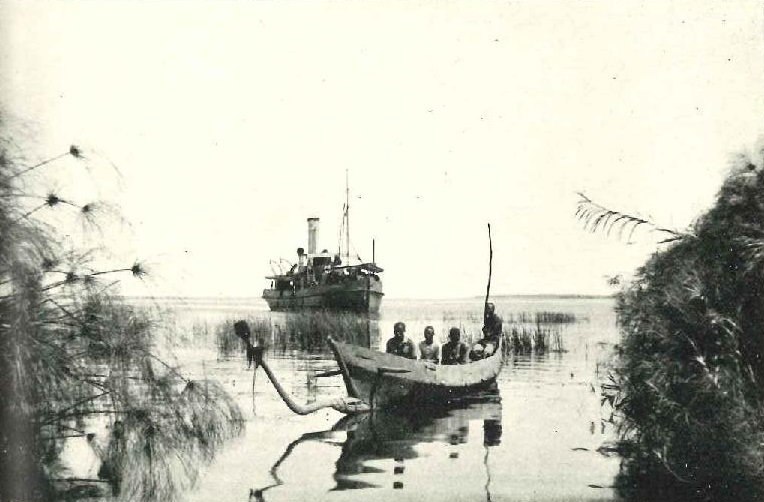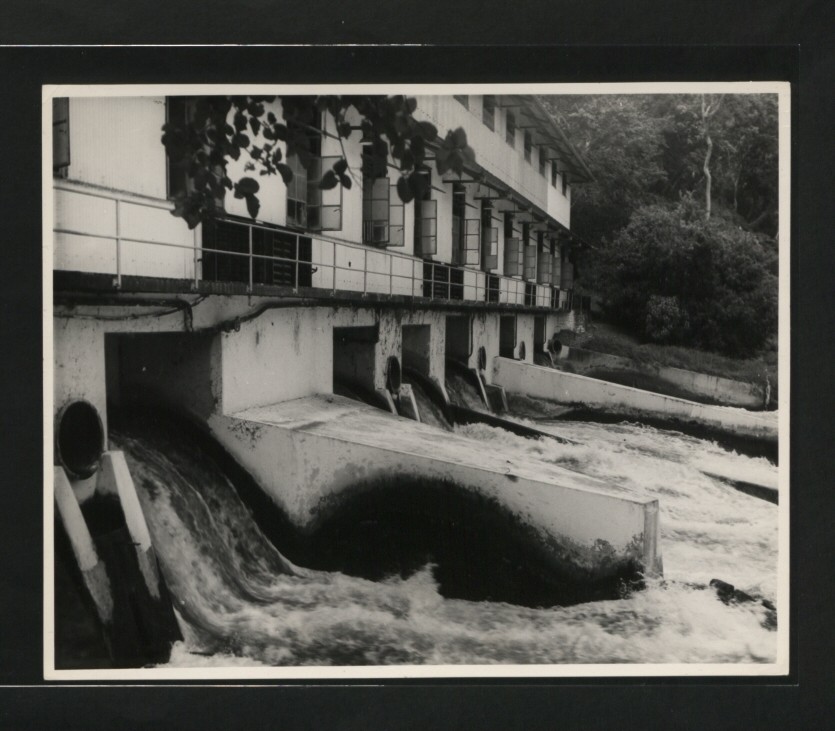|
Ngege
''Oreochromis esculentus'', the Singida tilapia or Graham's tilapia, is a species of cichlid Endemism, endemic to the Lake Victoria basin, including some of its satellite lakes such as Lake Kyoga, Kyoga, in Tanzania, Uganda, and Kenya. Its common name refers to Singida#Lake Singida, Lake Singida, but this population is the result of an Introduced species, introduction that happened in the 1950s. This fish was historically highly valued by local fishermen, who know it as ''ngege''. In 1927-1928 Michael Graham (scientist), Michael Graham conducted the first ever systematic Fisheries Survey of Lake Victoria. In his official report of the expedition, Graham wrote that "The ngege or satu ''Tilapia esculenta'', is the most important food fish of the lake, whether for native or non-native consumption. No other fish equals it in the quality of the flesh. It is convenient size for trade, travels well and is found in much greater numbers than other important fish, such as semutundu (Lugand ... [...More Info...] [...Related Items...] OR: [Wikipedia] [Google] [Baidu] |
Lake Victoria
Lake Victoria is one of the African Great Lakes. With a surface area of approximately , Lake Victoria is Africa's largest lake by area, the world's largest tropics, tropical lake, and the world's second-largest fresh water lake by surface area after Lake Superior in North America. In terms of volume, Lake Victoria is the world's list of lakes by volume, ninth-largest continental lake, containing about of water. Lake Victoria occupies a shallow Depression (geology), depression in Africa. The lake has an average depth of and a maximum depth of .United Nations, ''Development and Harmonisation of Environmental Laws Volume 1: Report on the Legal and Institutional Issues in the Lake Victoria Basin'', United Nations, 1999, page 17 Its drainage basin, catchment area covers . The lake has a shoreline of when digitized at the 1:25,000 level, with islands constituting 3.7% of this length. The lake's area is divided among three countries: Tanzania occupies 49% (), Uganda 45% (), and ... [...More Info...] [...Related Items...] OR: [Wikipedia] [Google] [Baidu] |
Fisheries Survey Of Lake Victoria
Lake Victoria supports Africa's largest inland fishery, with the majority of present catch being the invasive Nile perch, introduced to the Lake in the 1950s. Prior to the introduction of Nile perch as well as Nile tilapia, the fish community was very different and consisted mainly of 'Ngege' (''Oreochromis esculentus'') and Victoria tilapia (''O. variabilis'') as well as vast numbers of ''Haplochromis'' species. Fish communities in the first half of the 20th century are known primarily from a unique fisheries survey conducted in 1927-1928 by the Colonial Office. In 1927 Michael Graham (scientist), Michael Graham was sent from the fisheries laboratory in Lowestoft, together with Edgar Barton Worthington to spend a year surveying fisheries in Lake Nyanza (Lake Victoria).Graham M. (1929.) The Victoria Nyanza and Its Fisheries: A Report on the Fish Survey of Lake Victoria 1927–1928 and Appendices. London: Crown Agents for the Colonies. 256pp. This unique survey represents the firs ... [...More Info...] [...Related Items...] OR: [Wikipedia] [Google] [Baidu] |
Pangani River
The Pangani River (''Mto Pangani'', in Swahili language, Swahili), (also called Luffu and Jipe Ruvu, especially in older sources, and probably once called Rhaptus) is a major river of northeastern Tanzania. It has two main sources: the Ruvu Jipe River, Ruvu, which rises as River Lumi, Tanzania, Lumi at Kilimanjaro, passes through Lake Jipe, and empties into the Nyumba ya Mungu Reservoir, and the Kikuletwa River, coming from the west and mainly fed by rivers of Mount Meru (Tanzania), Mount Meru in Arusha Region, which also enters into the Nyumba ya Mungu Reservoir in Kilimanjaro Region. Just after leaving the reservoir the stream becomes the main Pangani, which empties into the Indian Ocean in Tanga Region at the Tangan port town of Pangani. For much of its length the river flows along the regional borders of Kilimanjaro Region and Manyara Region, before flowing into Tanga Region, which contains the 68 MW Pangani Power Station and the Pangani Falls Dam. There are several in ... [...More Info...] [...Related Items...] OR: [Wikipedia] [Google] [Baidu] |
Fish Of Lake Victoria
A fish (: fish or fishes) is an aquatic animal, aquatic, Anamniotes, anamniotic, gill-bearing vertebrate animal with swimming fish fin, fins and craniate, a hard skull, but lacking limb (anatomy), limbs with digit (anatomy), digits. Fish can be grouped into the more basal (phylogenetics), basal jawless fish and the more common jawed fish, the latter including all extant taxon, living cartilaginous fish, cartilaginous and bony fish, as well as the extinct placoderms and acanthodians. In a break to the long tradition of grouping all fish into a single Class (biology), class (Pisces), modern phylogenetics views fish as a paraphyletic group. Most fish are ectotherm, cold-blooded, their body temperature varying with the surrounding water, though some large nekton, active swimmers like white shark and tuna can hold a higher core temperature. Many fish can communication in aquatic animals#Acoustic, communicate acoustically with each other, such as during courtship displays. The stud ... [...More Info...] [...Related Items...] OR: [Wikipedia] [Google] [Baidu] |
Oreochromis
''Oreochromis'' is a large genus of oreochromine cichlids, fishes endemic to Africa and the Middle East. A few species from this genus have been introduced far outside their native range and are important in aquaculture. Many others have very small ranges; some are seriously threatened, and ''O. ismailiaensis'' and ''O. lidole'' possibly are extinct. Although ''Oreochromis'' primarily are freshwater fish of rivers, lakes and similar habitats, several species can also thrive in brackish waters and some even survive in hypersaline conditions with a salinity that far surpasses that of seawater. In addition to overfishing and habitat loss, some of the more localized species are threatened by the introduction of other, more widespread ''Oreochromis'' species into their ranges. This is because they—in addition to competing for the local resources—often are able to hybridize. ''Oreochromis'' are fairly robust fish, and medium–small to very large cichlids that can reach up to ... [...More Info...] [...Related Items...] OR: [Wikipedia] [Google] [Baidu] |
Nile Tilapia
The Nile tilapia (''Oreochromis niloticus'') is a species of tilapia, a cichlid occurring naturally in parts of Africa (such as its namesake Nile River) and the Levant, though numerous introduced populations exist outside its natural range. This current wide range is caused by its high commercial value as a food fish, where it is marketed as mango fish (not to be confused with the mango tilapia, or ''Sarotherodon galilaeus''), nilotica, or boulti, along with many other names, both local and foreign. Due to its value, the Nile tilapia is widely aquacultured across the world due to its hardiness and a mode of reproduction conducive to mass rearing, namely mouthbrooding, and various attempts have been made to increase production yields, including hybridization with other tilapias. Description The Nile tilapia reaches up to in length, and can exceed . As typical of tilapia, males reach a larger size and grow faster than females. Wild, natural-type Nile tilapias are brown ... [...More Info...] [...Related Items...] OR: [Wikipedia] [Google] [Baidu] |
Nile Perch
The Nile perch (''Lates niloticus''), also known as the African snook, Goliath perch, African barramundi, Goliath barramundi, Giant lates or the Victoria perch, is a species of freshwater fish in family Latidae of order Perciformes. It is widespread throughout much of the Afrotropical realm, being native to the Congo River, Congo, Nile River, Nile, Senegal River, Senegal, Niger River, Niger and Lake Chad, Lake Volta, Volta, Lake Turkana, and other river basins. It also occurs in the brackish waters of Lake Maryut in Egypt. The Nile perch is a fish of substantial economic and food-security importance in East Africa. Originally described as ''Labrus niloticus,'' among the marine wrasses, the species has also been referred to as ''Centropomus niloticus''. Common names include African snook, Victoria perch (a misleading trade name, as the species is not native to Lake Victoria, though they have been introduced there), and many local names in various African languages, such as the Luo ... [...More Info...] [...Related Items...] OR: [Wikipedia] [Google] [Baidu] |
Predator
Predation is a biological interaction in which one organism, the predator, kills and eats another organism, its prey. It is one of a family of common List of feeding behaviours, feeding behaviours that includes parasitism and micropredation (which usually do not kill the Host (biology), host) and parasitoidism (which always does, eventually). It is distinct from Scavenger, scavenging on dead prey, though many predators also scavenge; it overlaps with Herbivore, herbivory, as Seed predation, seed predators and destructive frugivores are predators. Predation behavior varies significantly depending on the organism. Many predators, especially carnivores, have evolved distinct hunting strategy, hunting strategies. Pursuit predation involves the active search for and pursuit of prey, whilst ambush predation, ambush predators instead wait for prey to present an opportunity for capture, and often use stealth or aggressive mimicry. Other predators are opportunism, opportunistic or om ... [...More Info...] [...Related Items...] OR: [Wikipedia] [Google] [Baidu] |
Standard Length
Fish measurement is the measuring of individual fish and various parts of fish anatomy, their anatomies, for data used in many areas of ichthyology, including Taxonomy (biology), taxonomy and fishery biology. Overall length Standard length (SL) is the length of a fish measured from the tip of the snout to the posterior end of the last vertebra or to the posterior end of the midlateral portion of the Glossary of ichthyology#H, hypural plate. This measurement excludes the length of the caudal fin, caudal (tail) fin. Total length (TL) is the length of a fish measured from the tip of the snout to the tip of the longer lobe of the caudal fin, usually measured with the lobes compressed along the midline. It is a straight-line measure, not measured over the curve of the body. Standard length measurements are used with Teleostei (most Actinopterygii, bony fish), while total length measurements are used with Myxini (hagfish), Petromyzontiformes (lampreys) and usually Elasmobranchii (shark ... [...More Info...] [...Related Items...] OR: [Wikipedia] [Google] [Baidu] |
Oreochromis Jipe
''Oreochromis'' is a large genus of oreochromine cichlids, fishes endemic to Africa and the Middle East. A few species from this genus have been introduced far outside their native range and are important in aquaculture. Many others have very small ranges; some are seriously threatened, and ''O. ismailiaensis'' and ''O. lidole'' possibly are extinct. Although ''Oreochromis'' primarily are freshwater fish of rivers, lakes and similar habitats, several species can also thrive in brackish waters and some even survive in hypersaline conditions with a salinity that far surpasses that of seawater. In addition to overfishing and habitat loss, some of the more localized species are threatened by the introduction of other, more widespread ''Oreochromis'' species into their ranges. This is because they—in addition to competing for the local resources—often are able to hybridize. ''Oreochromis'' are fairly robust fish, and medium–small to very large cichlids that can reach up ... [...More Info...] [...Related Items...] OR: [Wikipedia] [Google] [Baidu] |
Michael Graham (biologist)
Michael Graham (1898–1972) CMG OBE was a British fisheries scientist, author, and ecologist. He was the director of the Ministry of Agriculture, Fisheries and Food (United Kingdom) fisheries laboratory in Lowestoft (1945–1958), now known as the Centre for Environment, Fisheries and Aquaculture Science (Cefas). His classic book, ''The Fish Gate'', published in 1943, paints a picture of the near-collapse of the British fishing industry through overfishing that occurred before both the First and the Second World Wars. Biography Godfrey Michael Graham was born in Manchester on 22 February 1898, the son of the Quaker writer John William Graham (1859–1932) and Margaret Brockbank. As a boy he loved the Lake District and the wildlife he encountered on his relation's Cumberland farm. His outstanding interest at Bootham School in York was in natural history. During World War I he served in the Royal Navy and afterwards read Natural Science at King's College, Cambridge. His profess ... [...More Info...] [...Related Items...] OR: [Wikipedia] [Google] [Baidu] |







